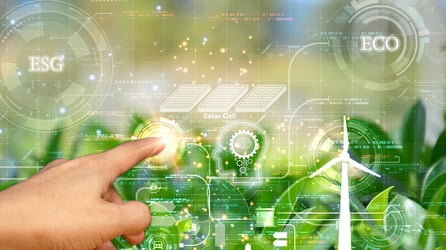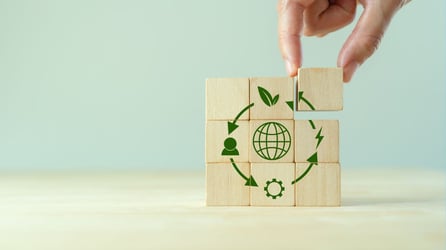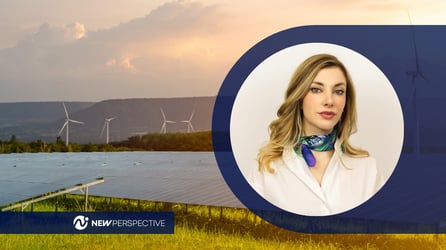The Ultimate Glossary of Sustainability & Climate Change Terms
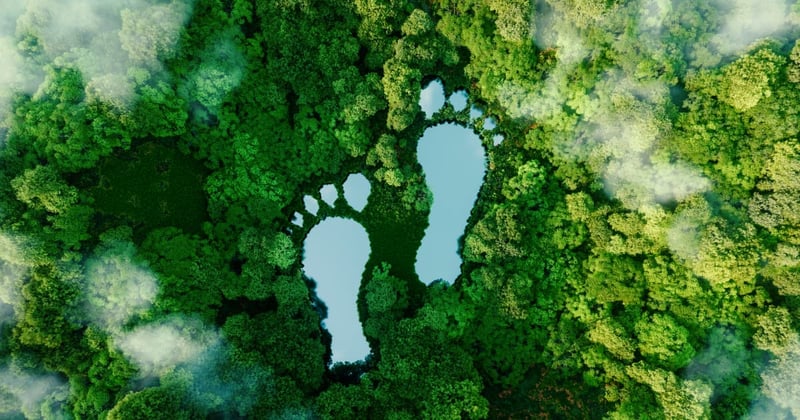
For B2B marketers, understanding the climate crisis is becoming critically important. The CMO Survey recently found that over 57% of marketers see their customers and partners shifting to climate-friendly products and demanding more transparency on climate impact. And the demand for climate-friendly services is strongest (almost 70%) among B2B companies.
Increasingly, marketers are leading the way on sustainability: they’re crafting the messaging and talking points, highlighting the initiatives, and addressing their target audience with a new focus on climate. But doing so means using a terminology that can seem unfamiliar at best.
With that in mind, we put together this A-Z (well, A-W) glossary of 40 sustainability terms you should know.
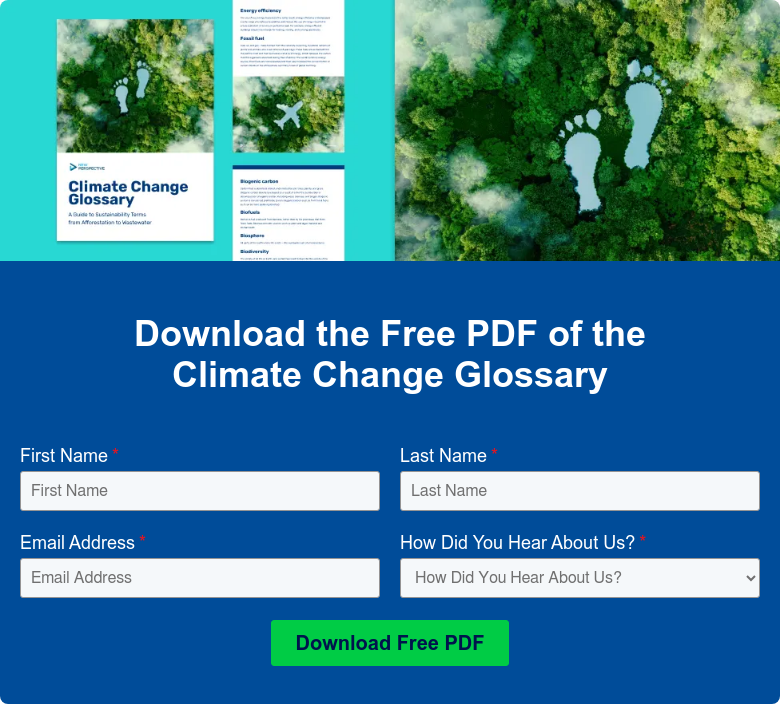
Glossary of Climate Change and Sustainability Terms
Afforestation
The planting of new trees and establishment of a forest in an area that had not previously been forested. Afforestation naturally increases carbon capture, as the trees remove and store CO2 from the atmosphere.
Alternative energy
Alternative energy refers to any energy source that does not come from fossil fuels, and therefore produces little to no greenhouse gas emissions and does not contribute to the greenhouse effect. The term includes renewable energy sources, as well as nuclear energy.
Anthropogenic
Caused by humans or originating in human activity. In a climate change context, anthropogenic climate change is the human impact on Earth’s climate, differing from natural climate change caused by the natural climate cycles occurring throughout Earth’s history.
Biogenic carbon
Carbon that is absorbed, stored, and emitted by soil, trees, plants, and grass. Biogenic carbon dioxide is released as a result of either the combustion or decomposition of organic matter, including wood, biomass, and biogas. Biogenic carbon is considered preferable to non-biogenic carbon such as from fossil fuels, as it can be more easily replenished.
Biofuels
Biofuel is fuel produced from biomass, rather than by the processes that form fossil fuels. Biomass includes sources such as plant and algae material and animal waste.
Biosphere
All parts of the earth where life exists — the worldwide sum of all ecosystems.
Biodiversity
The variety of all life on Earth, and sometimes used to describe the variety of life in a particular habitat, region or ecosystem. This includes all the animals, plants, fungi, as well as microorganisms such as bacteria. Biodiversity is essential for the processes that support life on Earth, since all species work together in ecosystems to provide balance and support life. Climate change is a threat to biodiversity as it changes many habitats faster than plants and wildlife can adapt.
Carbon footprint
The total amount of greenhouse gas emissions (including carbon and methane) generated by the actions of a person (or an entity such as an organization, place, or product). Expressed as a carbon dioxide equivalent, typically measured in tons.
Carbon capture
The process of trapping carbon dioxide from an emission source (usually an industrial process) before it enters the atmosphere. Usually used in conjunction with the terms carbon capture, utilization and storage (CCUS) or carbon capture and sequestration — when the captured carbon is stored deep underground.
Carbon neutral
A balance between carbon emissions and absorbing carbon from the atmosphere, so that there are net-zero carbon emissions. An organization is carbon neutral when any CO2 released into the atmosphere from their activities is balanced by the equivalent amount of CO2 being removed.
Carbon negative
A step beyond carbon neutral/net-zero emissions, with an organization removing more carbon than they emit.
Climate
The average weather in a given area over a long period of time (typically a minimum of 30 years).
Climate change
Long-term shifts in temperatures and weather patterns.
Climate positive
Synonymous with carbon negative – when an organization goes beyond climate neutrality or net-zero by removing more carbon from the atmosphere than they generate.
Deforestation
The purposeful removal of trees, converting forested land into cleared land. This is done so the land can be converted to another use, typically for farms, ranches, or urban development.
Desertification
A process in which fertile land becomes desert. This typically occurs in dry areas and results from drought, deforestation, climate change, improper agricultural practices and other human activities.
Ecosystem
A geographic area where plants, animals, and other organisms interact and form an interdependent biological community in a given physical environment. An ecosystem consists of both the physical environment (abiotic) and the living organisms that live in that environment (biotic).
Emissions
The production and sending out of something from a source, usually gas or radiation. In a climate change context, emissions refers to the sending out of various gasses (mostly carbon dioxide) that contribute to the greenhouse effect into the earth’s atmosphere, usually through the burning of fossil fuels or other industrial processes.
Energy efficiency
The use of less energy to produce the same result. Energy efficiency encompasses a wide range of practices to optimize and reduce the use of energy required to create a product or service or perform a task. For example, energy efficient buildings require less energy for heating, cooling, and running appliances.
Fossil fuel
Coal, oil, and gas – fuels formed from the naturally-occurring, fossilized remains of plants and animals who lived millions of years ago. These fuels are extracted from the earth’s crust and then burned as a source of energy, which releases the carbon that the organisms absorbed during their lifetimes. The world’s primary energy source, fossil fuels are nonrenewable and their use increases the concentration of carbon dioxide in the atmosphere, a primary cause of global warming.
Geosphere
The solid parts of the planet, composed of all the rocks and minerals on Earth, distinct from the hydrosphere and atmosphere. The geosphere reacts on geologic timescales, affecting climate slowly over millions of years.
Global warming
One aspect of climate change, global warming is the long-term rise of the earth’s temperatures. Observed since the pre-industrial period, global warming is caused by increased concentrations of greenhouse gasses in the atmosphere, mainly due to the burning of fossil fuels.
Global average temperature
An estimate of Earth’s surface air temperature averaged over the entire planet. It is a statistical indicator useful for assessing global climate change and demonstrating the fluctuation of the atmosphere over various timespans.
Greenhouse effect
The way in which the sun’s heat is trapped close to the earth’s surface by gasses in the atmosphere. The “greenhouse gasses” in the atmosphere prevent some heat from returning to space, making the planet warmer, similar to how a greenhouse works. This makes the earth a more comfortable place to live, but also drives global warming, as increasing concentrations of carbon dioxide and methane cause more heat to be trapped and average temperatures to rise.
Greenwashing
Greenwashing is when a company advertises itself as environmentally conscious for marketing purposes without making any real sustainability efforts. As a marketer, it’s important not to greenwash your company’s products and services with marketing spin that is deceptive about their true environmental impact.
Habitat fragmentation
The process by which parts of a habitat are destroyed, dividing a large, contiguous habitat into smaller, isolated areas. This can lead to a loss of biodiversity, as animal populations are split into smaller groups, increasing crowding, competition, inbreeding and disease exposure, and reducing access to water and food.
Hydrosphere
The total amount of water on Earth, including water on the surface, underground or in the air, in the form of liquid, vapor, or ice. The hydrosphere is distinct from the atmosphere or geosphere and is predominantly composed of the earth’s oceans, lakes, and rivers.
Indirect emissions
Greenhouse gas emissions that result from an organization’s activities but are emitted from sources owned by other organizations. This includes what are referred to as Scope 2 and Scope 3 emissions. Scope 2 emissions are from the use of purchased electricity and heating/cooling, while Scope 3 emissions are caused by a company’s supply chain, outsourced activities, and employee commuting and travel. These often comprise the largest source of a company’s emissions, as many components of modern businesses are outsourced.
Landfill
A place where garbage is buried under the soil, in order to dispose of waste material and build up low-lying land. Landfills are a major source of greenhouse gas emissions, as almost two thirds of landfill waste is biodegradable and releases CO2 and methane when decomposing. Landfills can also be a source of toxic leachate, formed when rainwater passes through the solid waste, requiring mitigations such as collection and processing or a thorough environmental cleanup to avoid groundwater contamination.
Megacities
Very large cities, typically with a population of more than 10 million people.
Natural gas
Naturally-occurring flammable gas, mainly made out of methane and other hydrocarbons. Natural gas is a major nonrenewable fossil fuel and energy source, as well as a raw material for other inputs, often found underground in association with crude oil.
Net zero
A balance between the greenhouse gasses emitted and the amount removed from the atmosphere. Organizations that set a Net Zero target are planning to completely negate the amount of greenhouse gasses they produce, adding no more than they take away. Synonymous with carbon neutral.
Nonbiogenic carbon
Carbon that is emitted from fossil fuels such as coal, oil, and gas. Nonbiogenic carbon is less preferable than biogenic carbon, as it releases a significant amount of non-renewable carbon in a short space of time that has not been absorbed by living matter.
Phenology
Nature’s calendar – the study of recurring biological events (such as when plants bloom, when leaves turn color, or when birds migrate) and how they are influenced by climate. Temperature and other climate factors (such as rainfall or humidity) have the largest impact on these events.
Recycling
The process of collecting, processing, and converting waste into new materials.
Reforestation
The process of planting trees in an area that previously had trees, but has been depleted through deforestation, clearcutting, or natural disturbances. Unlike afforestation, which is the planting of trees where they didn’t previously exist, reforestation is the restocking of existing forests and woodlands where the number of trees has decreased.
Renewable energy
Renewable energy is energy generated from natural processes that can be replenished over time, including sunlight, geothermal heat, wind, tidal, hydropower, and some forms of biomass. Renewable energy does not deplete natural resources or harm the environment. It is a subset of alternative energy, but not all alternative energy is renewable, such as nuclear power, which involves the mining of elements that are not naturally replenished.
Sea level rise
Sea level rise, or change, is an increase in the height of the ocean’s surface relative to land. Sea level rise is a result from global warming caused by GHG emissions, as a warming climate causes ice to melt and seawater to expand.
Scientists measure sea level rise in two ways: absolute and relative. Absolute sea level change refers to the height of the ocean surface above the center of the earth. It is a global reference that does not take into account the land in a given area.
But sea level rise does not occur at the same pace globally. Relative sea level change refers to how the sea level rises or falls relative to the land at a given location, taking into account whether the land is rising or falling with respect to the ocean surface.
Stratosphere
The second layer of Earth’s atmosphere, located above the troposphere and below the mesosphere. The stratosphere contains the ozone layer, which absorbs incoming UV radiation from the sun. Greenhouse gas emissions are shrinking the stratosphere, while the neighboring troposphere expands.
Wastewater
Used water — water that flows into the sewer after being used at home, in a business, or in an industrial process. Wastewater contaminates the environment, and leads to negative effects on existing water supplies and marine life, especially when it contains harmful chemicals, heavy metals, and other materials.

Work with a partner who understands sustainability
At New Perspective, we’re passionate about supporting companies that are trying to make our world a better place, be it through their technology or their aggressive sustainability/ESG initiatives. Many of our Cleantech clients boast breakthrough products and services for some of our most pressing worldwide issues. Their missions inspire us and drive our purpose.
Want to get started on great marketing strategies that cut down your carbon footprint as well? Reach out to schedule a conversation with us.


